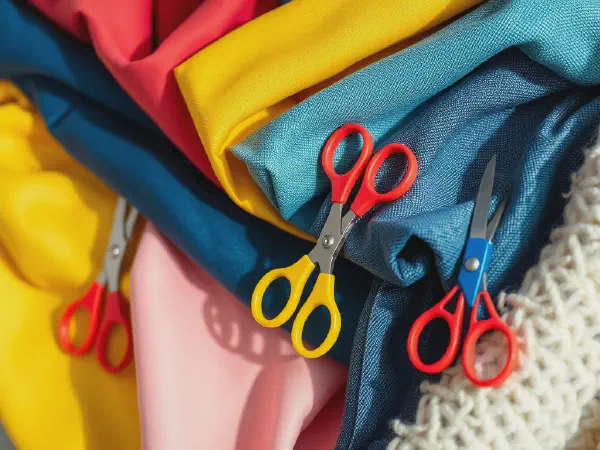Explore Fabric Types and the Best Scissors to Cut Them

Fabric Types and the Best Scissors to Cut Them
Understanding the diverse fabric types and the best scissors for cutting them is essential for any sewing enthusiast. Different fabrics possess unique qualities, and using the appropriate scissors can greatly enhance the cutting process, ensuring clean and precise edges.
Exploring fabric types and the best scissors to cut them can help you make informed decisions when embarking on sewing projects. From delicate silks to heavyweight denims, the fabric you choose will influence the tools you employ. Selecting the right scissors will ensure that the fabric is cut accurately and with ease, which is crucial for the overall success of your project.
Fabric types encompass a wide range of materials, including natural fibers like cotton and wool, and synthetic options such as polyester. Knowing the characteristics of each fabric type will guide you to choose not only the right scissors but also the proper techniques for cutting. Whether you're a novice or a seasoned sewer, understanding fabric types and the best scissors to cut them can elevate your sewing game.
The best scissors for cutting fabrics differ depending on the thickness, texture, and composition of the material. In this article, we will discuss both common fabric types and specialized tools to help you make the best choices for your sewing projects. This information will also include practical cutting techniques to enhance your workflow and result in professional-quality finishes.
From tools to techniques, mastering fabric types and the best scissors to cut them will empower your sewing experience. Taking the time to understand the materials you work with and using the correct tools will yield beautiful results that you can be proud of.
Common Fabric Types
Fabric types are broadly categorized into natural and synthetic fibers. Natural fibers include cotton, wool, silk, and linen, while synthetic fibers are derived from chemical processes, such as polyester, nylon, and spandex. Understanding the attributes of these fibers helps in choosing the right fabric for your sewing projects and the corresponding cutting tools needed for each.
Cotton fabric is one of the most popular choices for sewing due to its versatility, breathability, and softness. Cotton is easy to work with and can be washed and dried without damage. It is available in various weights and prints, making it suitable for clothing, quilting, and home decor. Cotton's stability during cutting also makes it an excellent fabric choice for beginners.
Silk fabric is luxurious and has a natural sheen, making it ideal for elegant garments and special occasions. Silk drapes beautifully and feels soft against the skin. However, its slippery nature requires the use of specialized scissors to ensure clean cuts. When working with silk, it's best to have fabric scissors or shears that provide a smooth cutting action without snagging the fibers.
Wool fabric is known for its warmth and durability, making it excellent for winter clothing. Wool is available in various weights, from lightweight to heavily textured. When cutting wool, sharp scissors are essential to navigate through its fibers cleanly. Ensure that your scissors are specifically designed for cutting thicker fabrics to achieve the best results.
Denim fabric is a sturdy cotton twill known for its durability and iconic look. It is widely used in jeans and other casual wear. The thickness of denim requires robust, heavy-duty scissors or shears designed to cut through several layers at once. Using the wrong scissors can lead to fatigue and uneven cuts, so it's vital to select the best tools for this fabric.
Choosing the Right Scissors
There are several types of scissors used for sewing, each tailored to specific tasks. Fabric scissors are designed for cutting fabric, while dressmaker scissors are larger and often favored for cutting through multiple layers. Pinking shears, with their zigzag edges, are perfect for preventing fraying in woven fabrics. Each type of scissor has a distinct purpose, and understanding their uses will help you avoid damage to your fabrics.
The blade material affects cutting performance significantly. Stainless steel blades offer durability and corrosion resistance, while carbon steel is known for its sharpness and ability to maintain an edge longer. Opting for high-quality blades is essential when selecting scissors for cutting various fabric types, as it can ensure precise cuts and minimize the risk of fabric damage.
Ergonomic design plays an important role in the comfort and efficiency of scissors. Choosing fitted handles that consider hand shape and grip reduces strain during prolonged use, particularly when cutting thicker fabrics or multiple layers. Look for scissors with padded handles or those designed specifically for enhanced comfort and control.
Specialty scissors are available for unique fabrics, like eyelash or fur, that may require specific cutting techniques. These scissors often feature specialized blade designs to ensure a clean cut without damaging the fabric. Utilizing the right specialty scissors can simplify the cutting process and lead to better final results.
Maintaining your scissors is vital for optimal performance. Regularly sharpen blades to ensure clean cuts and avoid fabric fraying. Clean your scissors after each use to remove sticky residue or lint. Proper storage also helps preserve the blades' edge and prevents accidental damage to the scissors or fabric during storage.
Techniques for Cutting Fabrics
Cutting fabric on the bias refers to cutting diagonally across the weave, which enhances the fabric's drape and stretch. This technique is particularly beneficial for garments that require a fit or flow. It's essential to cut accurately and enlist the right scissors to achieve clean angles when working with bias-cut pieces.
Using patterns adds precision when cutting fabric. Whether a commercial pattern or an original design, applying patterns helps in accurately cutting the fabric according to the desired shape. It's crucial to ensure that the notches and markings are visible and easy to follow, contributing to a seamless sewing process.
Layering fabric can lead to accurate cuts, especially during larger projects. Stabilizing layers with weights or pins before cutting reduces movement and ensures clean edges. This technique is particularly useful in quilting or when cutting multiple layers of the same fabric type.
To avoid fraying, consider pinking shears for woven fabrics or using a zigzag stitch along the edges after cutting. Additionally, limiting handling of the cut fabric and using cutting mats can minimize the chances of fray and maintain the integrity of the fabric edges.
Best practices for cutting curves involve using sharp scissors and taking your time to cut slowly along the curve's outline. Small, curved scissors can also aid in achieving detailed cuts without distorting the fabric's shape, ensuring intricate designs maintain their intended appearance.
Specialty Fabrics and Tools
Cutting chiffon and lace fabric requires a gentle touch due to their delicate nature. Employing sharp scissors specifically designed for fine fabrics can minimize the risk of snags or tears. Additionally, consider using weights instead of pins to avoid leaving marks on these ethereal fabrics.
For thick materials like leather, heavy-duty scissors or rotary cutters are essential. These tools are designed to handle the toughness of leather, ensuring clean and even cuts without damaging the material. Always select scissors with sturdy blades for these types of fabrics.
Using rotary cutters is a great option for quilting fabrics. They provide the precision needed for straight cuts. Pairing rotary cutters with self-healing mats enables accurate cutting without harming the blade or the cutting surface, making them ideal for patchwork designs.
When it comes to cutting wool, shears are typically preferred due to their ability to smoothly glide over the fabric. Regular scissors may snag or pull the wool fibers, leading to uneven cuts. Investing in high-quality fabric shears can significantly enhance your experience.
Best practices for cutting slippery fabrics involve securing the fabric with weights and using smooth, sharp scissors to ensure clean lines. Cutting slowly and avoiding fabric shifting will lead to better results and prevent excess fraying, especially with slinky materials.
Sewing Projects by Fabric Type
Cotton fabrics are ideal for various projects, including quilts, casual clothing, and accessories like bags and pouches. The wide range of prints and solid colors also allows for creativity in design, making it a favorite among crafters and sewists.
Silk is perfect for elegant dresses, blouses, and lightweight scarves. The luxurious drape creates beautiful silhouettes, making silk a coveted choice for evening wear and special occasions, showcasing skillful sewing techniques with its delicate nature.
Denim is versatile for crafting bags, jackets, and durable home decor items. Its strength and visual appeal make it an excellent choice for creative projects, including patches, embroidery, or mixed-media applications.
Wool is commonly chosen for cozy sweaters, hats, and blankets. Its insulation properties provide warmth, while the variety of textures available can add depth and dimension to any winter garment.
For home decor, unique fabric choices such as upholstery fabric, canvas, or burlap can add character to your space. These fabrics allow for fun projects like cushions, curtains, or DIY furniture, making your home feel personal and inviting.
